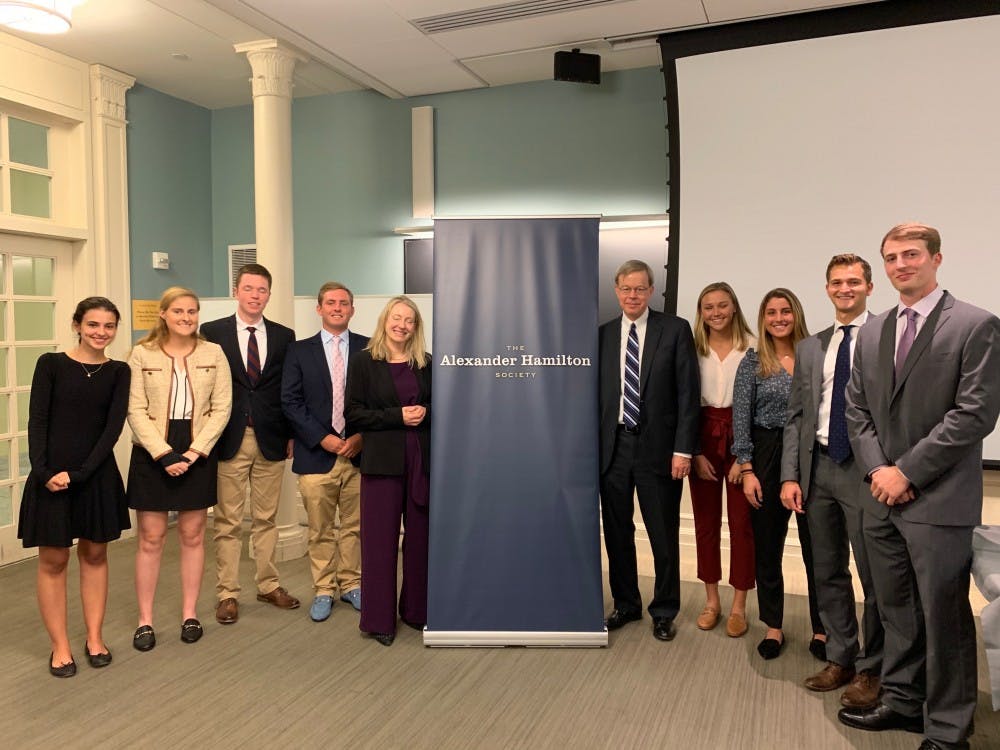The Hopkins chapter of the Alexander Hamilton Society (AHS) hosted its first event of the year, a discussion on bioterrorism, titled “Bioterrorism and U.S. Security” last Thursday, Oct. 10. The discussion brought former U.S. Sen. Jim Talent of Missouri and Bloomberg School of Public Health Associate Professor Gigi Gronvall to Gilman Hall. AHS is a national organization that is dedicated to educating students on issues of foreign policy and geopolitics.
Talent served as the vice chairman of the bipartisan Commission on the Prevention of Weapons of Mass Destruction (WMD) Proliferation and Terrorism. Gronvall served as the science advisor to this commission. Gronvall is also currently a member of the Threat Reduction Advisory Committee (TRAC), which is an advisory group to the Department of Defense on issues of national security.
Both panelists began with a brief history of bioterrorism and its prevalence as a security issue. Gronvall explained that while many countries used to have biological weapons programs in the World War II era, all nation-states have since agreed to refrain from utilizing bioweapons, passing a treaty to this effect in 1972.
Talent offered a definition of bioweapons.
“Bioweapons are pathogens harmful to human health that are weaponized and delivered to a human population,” he said.
Since then, all uses of bioterrorism have been by non-state actors. Gronvall spoke to the increasing accessibility of biology.
“Biology has become democratized as a science,” Gronvall said. “It is used almost entirely for good, but there is still potential for misuse.”
As members of the Commission on the Prevention of WMD Proliferation and Terrorism, both Talent and Gronvall assisted in assessing the current state of the United States government’s preparedness for a bioterror attack. The Commission offered a series of reports that provide such assessments and include steps for more comprehensive prevention activities, initiatives and programs.
Both speakers opined about the status of the government to counter such an event if it were to happen.
“Government spending on security is not consistent with the environment in which we live,” Talent said. “We need to spend more.”
Gronvall described certain workshops that were held to simulate bioterror attacks, including one known as Claydex.
“Claydex was exercise funded by open philanthropy that employed a fictional disease to demonstrate the challenges that come with bioterrorism or a naturally occurring outbreak,” Gronvall said. “The purpose was to educate people and show them what it would be like and to point out response deficiencies.”
Gronvall and Talent then delved into why the American capabilities of countering bioterrorism are weaker than preferred.
Talent gave his thoughts on this issue as a former politician who was tasked with conducting similar research previously.
“There are structural issues in the legislative process. Congress needs to find a way to be more functional,” Talent said. “These issues are not only due to partisanship but because legislative processes are gummed up.”
Gronvall agreed with Talent’s depiction of legislators’ ability to make effective change in the field of bioterrorism research.
“Politicians don’t have experience with public health or life sciences, so they have no idea how to deal with a problem like this,” she said.
Talent continued to describe the measures that have been recommended by groups such as the Commission on the Prevention of WMD. He described what he called the links in the chain of resilience to bioweapons attacks. These links include detection and diagnosis of an attack, attribution to its source, communication of procedure to those affected, medical countermeasures, and distribution of these countermeasures.
“The quicker and more effectively you respond, the more limited the effects can be, and the less likely you are to be hit,” Talent said.
A point made by both Talent and Gronvall resonated with the audience of the discussion.
“In America, the urgent is constantly crowding out the important,” said Talent. “A bioterror attack is not a high-probability event, but the risk is unacceptably high.”
Freshman Dom Varier described his thoughts on the talk and mentioned his appreciation for a hypothetical presented during the talk.
“This was a nice way to explain a topic that we don’t usually talk about, and it’s a very important topic,” Varier said. “I really liked how they talked about the outbreak scenario. It’s a very extreme scenario, but it showed how potentially weak we are to bioterror attacks.”
Senior and AHS President Elliot Seckler agreed with Varier, affirming the importance of holding the talk and describing the effect it had on the students who attended.
“The discussion opened up a lot of further issues that the students wanted to learn more about,” Seckler said. “This is the first time a lot of students are hearing about some of these issues, so we were happy to see the turnout and the event being well-received.”
This year marks the 10th anniversary of University’s chapter of the AHS.





